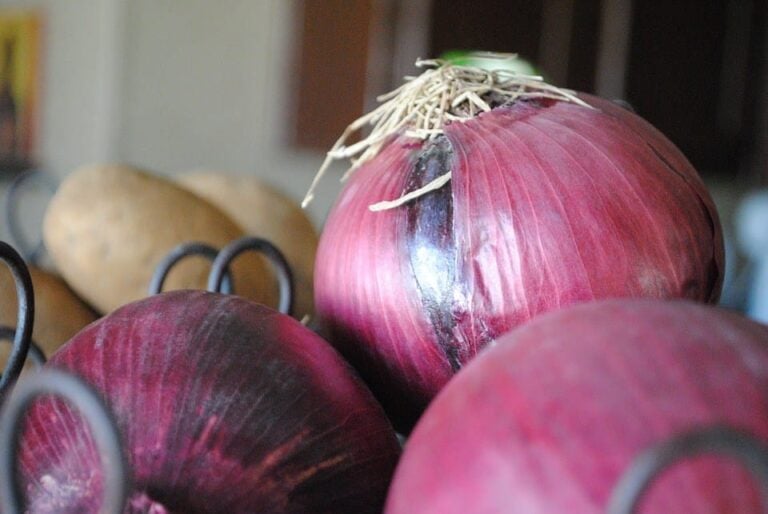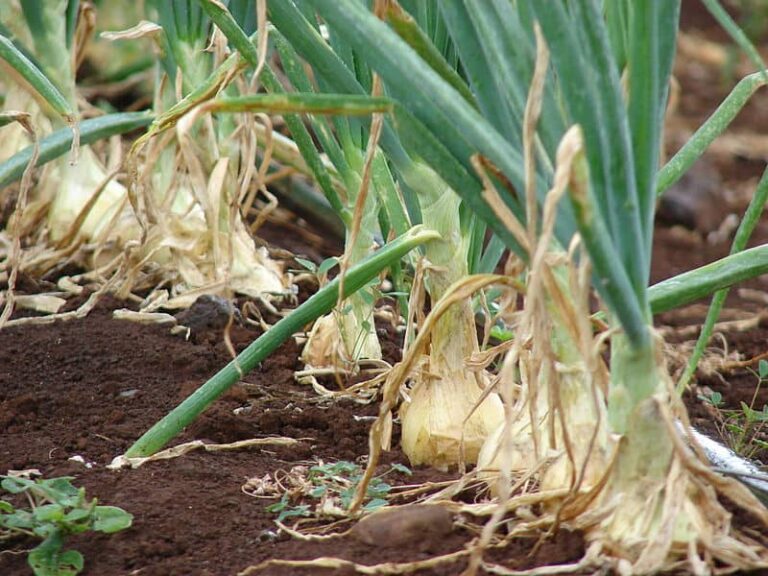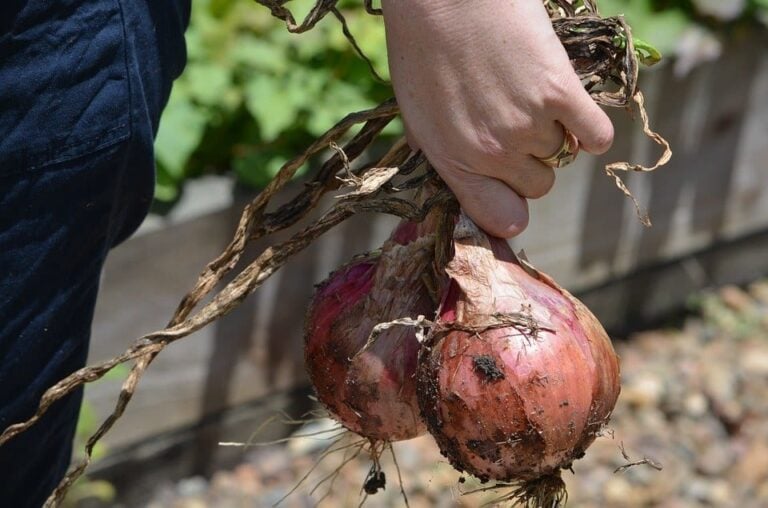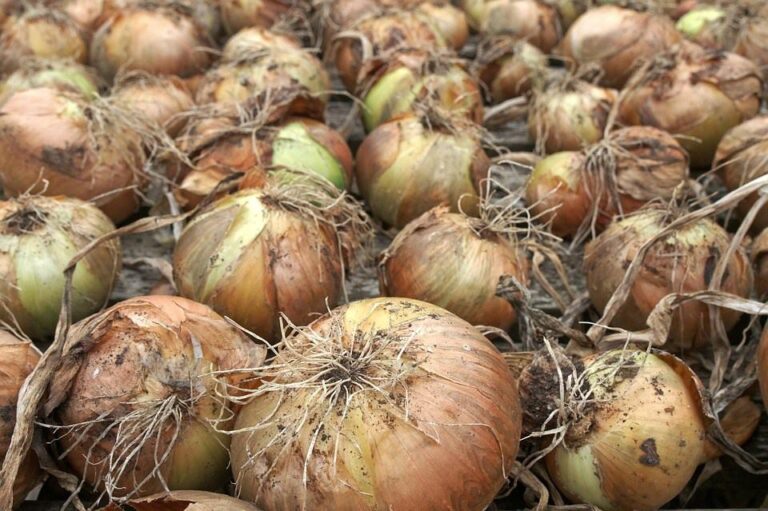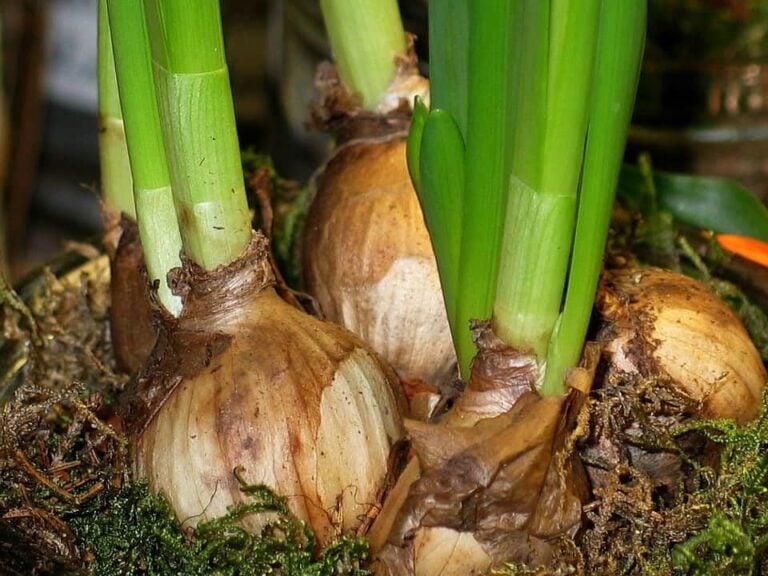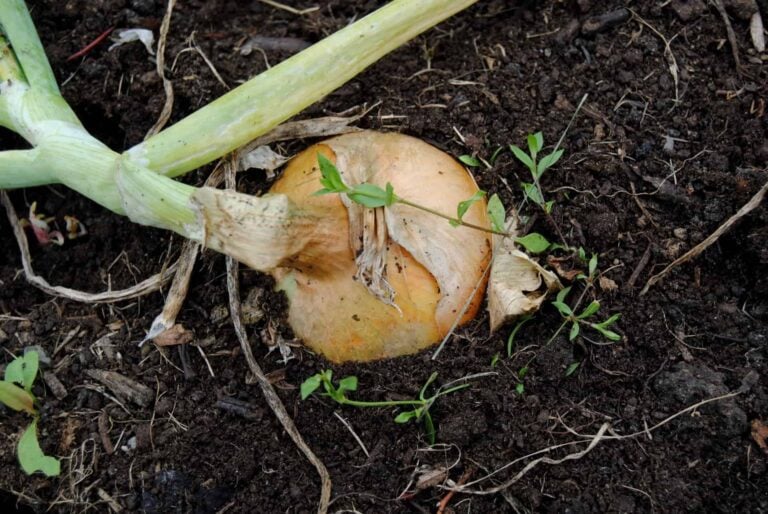Do Onions Grow Underground?
Onions are one of the vegetables that are consumed the most frequently and can be found in some form or another in almost every cuisine that can be found around the world. Onions are considered to be one of the healthiest vegetables. If you haven’t grown them before, you might be confused about whether they emerge from the ground or the air. While we’re all familiar with the phrase, you may be curious about the process of onion cultivation and where exactly you’ll find your first bunch. Onions are sometimes categorised as both a root vegetable and an above-ground vegetable.
Your question has been answered since the onion bulb develops underground while the remaining onion tips develop above ground.
The onion is a kind of vegetable that is included under the genus Allium. Onions are also known as leeks. Two growth seasons are required for the completion of the life cycle of biennials.
Onions are produced with their bulbs grown above ground and their roots grown below the surface of the soil. The bulb of onion is not the plant’s root; rather, it is a modified stalk. The edible component of onion is the bulb. In point of fact, the plant’s roots are attached to the base of the bulb; as a consequence of this connection, the roots are often rather short. When the bulb dries up, this portion of the plant shrivels up and eventually falls off.
What Are the Various Kinds of Onions That Are Available?
Even though there are a great number of varieties of onions, only a few of them are typically sold in grocery stores. Bulbing onions and non-bulbing onions are the two most common varieties of onions.
Onion Bulbs
What we refer to as “onion bulbs” at the grocery store are really dried bulbs that have been harvested from onions after they have been allowed to wither and their top growth and bottom roots have been removed. It may come as a surprise to realise that the so-called “fresh” onions offered in supermarkets are sometimes six to eight months old. This information may be found in many cases.
Onions Without Bulbs
The spring onion, which can have other colours besides green, is the non-bulbing kind that is most widely recognised. A few of the cultivars have a crimson base at the very bottom of the stem, but as they grow, they become green.
Due to the fact that they are grown using bulbing types, most of the spring onions that are offered in large supermarkets are actually picked when they are still quite young. This is an essential fact to keep in mind. Scallions do not have bulbs in their unadulterated form.
Varieties of onions that are started from bulbs may be divided into three categories: short-day, medium-day, and long-day. When gardeners refer to this category, they are referring to the number of daylight hours that are necessary for a plant to produce blooms or fruit. Every onion begins its life as a fragile green sprout, regardless of the final variety that it will become. The development of the stalk progresses from a stage similar to that of chives to a stage similar to that of spring onions.
Some onions are picked at this time of year and marketed as spring onions, but if you let them remain in the ground for an extended period of time, they will ultimately develop bulbs. There are several varieties of onions, each of which may be cultivated in a certain region of the world.
Further from the equator, there is the potential to cultivate a greater variety of species. The following is a brief explanation of the many different varieties of bulb onions.
Long Onions for a Short Day
Onions need 10–12 hours of sunshine every day in order to develop a bulb throughout their growing season. Only these cultivars, however, have a chance of flourishing in climates that are greater than 35 degrees north or south of the equator. Because they contain more water and sugar than the other onions in this group, the onions in this group have a flavour that is sweeter. Because the increased amount of water in them causes them to have a shorter shelf life, you ought to consume them as soon as you possibly can in order to get the most out of them.
Onions with a Day-Intermediate Ripeness
In order for these sorts of bulbs to produce flowers, the average daily light period must be between 13 and 14 hours. They are most content at latitudes that are between 35 and 45 degrees north of the equator. You can find them there.
Onions are the best item you can eat to sustain you over a long and challenging day. Onions may be effectively cultivated in latitudes of 45 degrees or above; any lower, and they won’t grow. In order for these plants to produce a bulb, they require at least 15 hours of sunshine each day. If onions are allowed to remain buried, what happens to them?
When left in the ground, onions have the potential to produce other bulbs.
Onions, like garlic, may be dug up, divided, and replanted in different areas if they are harvested while still young.
In addition, if the onion is not picked, the seed will start to germinate and produce new plants.
There are varieties of onions that have long stalks that culminate in clumps of white blossoms. As the plant begins to open, the petals of the flower will begin to break off. When the pods are broken apart, you may access the onion seeds that are contained within the blossoms.
How Far Underground Should You Put Onions When You Plant Them?
Planting spacing for onions should be between 2 and 6 inches. After that, you should make every effort to align the bulb with the terminal, and you shouldn’t bury it any deeper than an inch.
It’s important not to plant the onions too deeply, as doing so might stifle their growth.
Can I Grow One Onion From Another?
The force of multiplication may be easily shown in action by growing onion from its seed in a short amount of time. Slicing an onion in half lengthwise is all that is required to plant it in the ground.
Cuttings from onions can be used to root and grow new onion plants. If you start with an onion and give it 90–120 days, you can grow another onion.
Now, let’s have a look at the detailed guide!
- To maximise nutritional value, peel and trim the onion to a length of about 2.5 inches before chopping. You may use any type of onion you choose, even those from the grocery store, but fresh onions are best.
- The next step is to dry the onion slices for a full day after slicing them.
- Using four toothpicks make an ‘X’ on each side of the onion by placing two on top of each other.
- Setting out a shallow bowl of water on a tabletop.
- The onion should be positioned in the bowl so that its base is submerged in the water.
- Ideally, you should wait three to four days before using it.
When Should We Expect Onions To Reach Their Full Developmental Potential?
As was said earlier in the text, onions can be harvested and consumed at any time throughout their growth; however, on average, full maturity is attained after six to eight months. At this point, onions may be stored without risk for a very considerable amount of time.
How to Cultivate Onions
Due to the fact that onions are hardy plants that can withstand temperatures as low as -6 degrees Celsius (20 degrees Fahrenheit), there is a broad window of opportunity for planting them. The cultivation of onions is simple, and one may choose between onion seeds and onion sets (tiny bulbs).
The optimal time to plant seeds is generally considered to be between the end of winter and the beginning of spring; however, the exact timing of when to do so might vary greatly depending on the environment of the area. It is feasible to plant onion seeds in the fall in locations with warmer winters, but doing so will only push the harvest ahead by a few weeks rather than by many months.
Although onion seeds can be planted directly into the ground, I have found that starting them in modular trays gives me greater control over the conditions in which they grow and frees up valuable garden space for later winter crops. Although onion seeds can be planted directly into the ground, I find that starting them in modular trays gives me greater control over the conditions in which they grow.
Onions with Multiple Seeds
- Contrary to what most people believe, growing onions in clusters rather than separating them far apart really produces superior results. The process of planting many rows of seeds at once, commonly known as multi-sowing, offers a number of advantageous outcomes.
- The fact that it takes up less room on a serving tray is undoubtedly one of its many benefits. There is enough for up to 150 plants on a modular tray that has 30 compartments. The second significant advantage is that the clumps may be transplanted more rapidly and with less root injury.
- The third and last primary advantage is that it makes it easier to control weeds. This is accomplished by allowing the clumps to be spaced out to a reasonable distance, say 10 inches, which makes it easy to use a Dutch hoe to get rid of weeds.
However, keep in mind that there is a limit to the size of the clusters. This is quite significant. When there are more than four or five plants in a cluster, the result is a crop of baby onions. By sowing between five and seven seeds in each module, you can ensure that you will have at least four seedlings from each clump. This is because overgrown clumps may be trimmed down before being transplanted.
Plant seeds at a depth of one centimetre (0.5 inches), and make sure they receive plenty of water. It takes around six weeks for seeds to mature, but the plants can be kept in the trays for longer if there isn’t enough places in the garden for them yet.
When the seedling groups have reached a size of around 12 inches (30 cm), move them to a site that gets plenty of sunlight. The soil in which onion crops are cultivated should ideally be rich, wet, and somewhat acidic; nonetheless, the plants are remarkably tolerant of a wide range of conditions in this respect.
Once they have been planted, onions require nothing in the way of upkeep other than routine watering and weeding.
The Harvesting of Onions and Their Storage
However, in order to achieve their maximum size and flavour potential, onions should be allowed to grow to their full potential before being harvested and consumed. Onions, like other vegetables, can be harvested and consumed at any time. When onions have reached their full size, they stop growing and the green tops of their plants begin to turn brown and die off.
In most cases, two weeks of drying time is required for onions before they can be preserved. Onions that have been dried out to the point where their skin turns flaky also have stems that have shrunk.The best way to store onions is in hessian bags, but stackable bread boxes, which are also an excellent alternative because they are large and flat and have many holes, can also be used.
The Bottom Line
Onions are not just an essential ingredient in almost any dish, but they are also surprisingly simple vegetables to cultivate. We hope that now you know the answer to the age-old issue of whether or not onions can be cultivated below ground.

